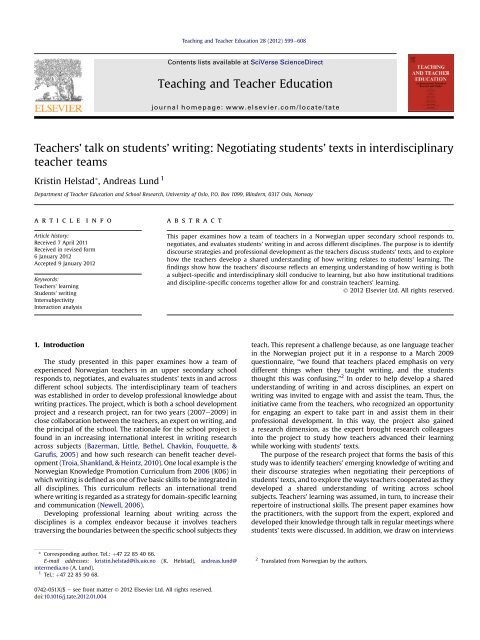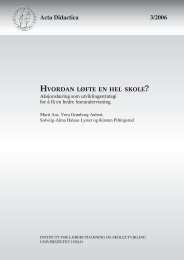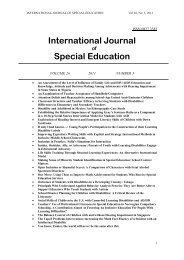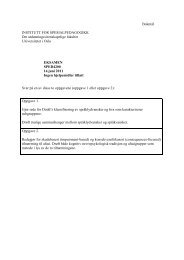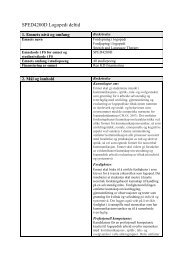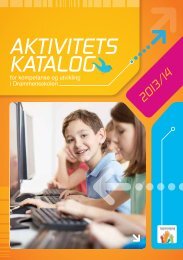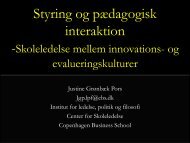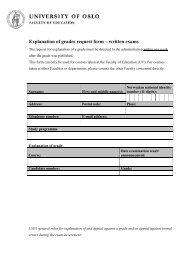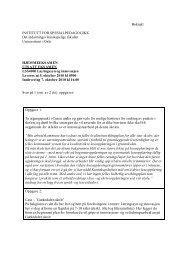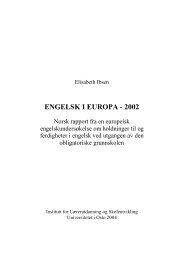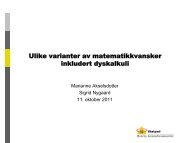Teachers' talk on students' writing: Negotiating students' texts in ...
Teachers' talk on students' writing: Negotiating students' texts in ...
Teachers' talk on students' writing: Negotiating students' texts in ...
You also want an ePaper? Increase the reach of your titles
YUMPU automatically turns print PDFs into web optimized ePapers that Google loves.
Teach<strong>in</strong>g and Teacher Educati<strong>on</strong> 28 (2012) 599e608C<strong>on</strong>tents lists available at SciVerse ScienceDirectTeach<strong>in</strong>g and Teacher Educati<strong>on</strong>journal homepage: www.elsevier.com/locate/tateTeachers’ <str<strong>on</strong>g>talk</str<strong>on</strong>g> <strong>on</strong> students’ <strong>writ<strong>in</strong>g</strong>: <strong>Negotiat<strong>in</strong>g</strong> students’ <strong>texts</strong> <strong>in</strong> <strong>in</strong>terdiscipl<strong>in</strong>aryteacher teamsKrist<strong>in</strong> Helstad * , Andreas Lund 1Department of Teacher Educati<strong>on</strong> and School Research, University of Oslo, P.O. Box 1099, Bl<strong>in</strong>dern, 0317 Oslo, Norwayarticle<strong>in</strong>foabstractArticle history:Received 7 April 2011Received <strong>in</strong> revised form6 January 2012Accepted 9 January 2012Keywords:Teachers’ learn<strong>in</strong>gStudents’ <strong>writ<strong>in</strong>g</strong>IntersubjectivityInteracti<strong>on</strong> analysisThis paper exam<strong>in</strong>es how a team of teachers <strong>in</strong> a Norwegian upper sec<strong>on</strong>dary school resp<strong>on</strong>ds to,negotiates, and evaluates students’ <strong>writ<strong>in</strong>g</strong> <strong>in</strong> and across different discipl<strong>in</strong>es. The purpose is to identifydiscourse strategies and professi<strong>on</strong>al development as the teachers discuss students’ <strong>texts</strong>, and to explorehow the teachers develop a shared understand<strong>in</strong>g of how <strong>writ<strong>in</strong>g</strong> relates to students’ learn<strong>in</strong>g. Thef<strong>in</strong>d<strong>in</strong>gs show how the teachers’ discourse reflects an emerg<strong>in</strong>g understand<strong>in</strong>g of how <strong>writ<strong>in</strong>g</strong> is botha subject-specific and <strong>in</strong>terdiscipl<strong>in</strong>ary skill c<strong>on</strong>ducive to learn<strong>in</strong>g, but also how <strong>in</strong>stituti<strong>on</strong>al traditi<strong>on</strong>sand discipl<strong>in</strong>e-specific c<strong>on</strong>cerns together allow for and c<strong>on</strong>stra<strong>in</strong> teachers’ learn<strong>in</strong>g.Ó 2012 Elsevier Ltd. All rights reserved.1. Introducti<strong>on</strong>The study presented <strong>in</strong> this paper exam<strong>in</strong>es how a team ofexperienced Norwegian teachers <strong>in</strong> an upper sec<strong>on</strong>dary schoolresp<strong>on</strong>ds to, negotiates, and evaluates students’ <strong>texts</strong> <strong>in</strong> and acrossdifferent school subjects. The <strong>in</strong>terdiscipl<strong>in</strong>ary team of teacherswas established <strong>in</strong> order to develop professi<strong>on</strong>al knowledge about<strong>writ<strong>in</strong>g</strong> practices. The project, which is both a school developmentproject and a research project, ran for two years (2007e2009) <strong>in</strong>close collaborati<strong>on</strong> between the teachers, an expert <strong>on</strong> <strong>writ<strong>in</strong>g</strong>, andthe pr<strong>in</strong>cipal of the school. The rati<strong>on</strong>ale for the school project isfound <strong>in</strong> an <strong>in</strong>creas<strong>in</strong>g <strong>in</strong>ternati<strong>on</strong>al <strong>in</strong>terest <strong>in</strong> <strong>writ<strong>in</strong>g</strong> researchacross subjects (Bazerman, Little, Bethel, Chavk<strong>in</strong>, Fouquette, &Garufis, 2005) and how such research can benefit teacher development(Troia, Shankland, & He<strong>in</strong>tz, 2010). One local example is theNorwegian Knowledge Promoti<strong>on</strong> Curriculum from 2006 (K06) <strong>in</strong>which <strong>writ<strong>in</strong>g</strong> is def<strong>in</strong>ed as <strong>on</strong>e of five basic skills to be <strong>in</strong>tegrated <strong>in</strong>all discipl<strong>in</strong>es. This curriculum reflects an <strong>in</strong>ternati<strong>on</strong>al trendwhere <strong>writ<strong>in</strong>g</strong> is regarded as a strategy for doma<strong>in</strong>-specific learn<strong>in</strong>gand communicati<strong>on</strong> (Newell, 2006).Develop<strong>in</strong>g professi<strong>on</strong>al learn<strong>in</strong>g about <strong>writ<strong>in</strong>g</strong> across thediscipl<strong>in</strong>es is a complex endeavor because it <strong>in</strong>volves teacherstravers<strong>in</strong>g the boundaries between the specific school subjects theyteach. This represent a challenge because, as <strong>on</strong>e language teacher<strong>in</strong> the Norwegian project put it <strong>in</strong> a resp<strong>on</strong>se to a March 2009questi<strong>on</strong>naire, “we found that teachers placed emphasis <strong>on</strong> verydifferent th<strong>in</strong>gs when they taught <strong>writ<strong>in</strong>g</strong>, and the studentsthought this was c<strong>on</strong>fus<strong>in</strong>g.” 2 In order to help develop a sharedunderstand<strong>in</strong>g of <strong>writ<strong>in</strong>g</strong> <strong>in</strong> and across discipl<strong>in</strong>es, an expert <strong>on</strong><strong>writ<strong>in</strong>g</strong> was <strong>in</strong>vited to engage with and assist the team. Thus, the<strong>in</strong>itiative came from the teachers, who recognized an opportunityfor engag<strong>in</strong>g an expert to take part <strong>in</strong> and assist them <strong>in</strong> theirprofessi<strong>on</strong>al development. In this way, the project also ga<strong>in</strong>eda research dimensi<strong>on</strong>, as the expert brought research colleagues<strong>in</strong>to the project to study how teachers advanced their learn<strong>in</strong>gwhile work<strong>in</strong>g with students’ <strong>texts</strong>.The purpose of the research project that forms the basis of thisstudy was to identify teachers’ emerg<strong>in</strong>g knowledge of <strong>writ<strong>in</strong>g</strong> andtheir discourse strategies when negotiat<strong>in</strong>g their percepti<strong>on</strong>s ofstudents’ <strong>texts</strong>, and to explore the ways teachers cooperated as theydeveloped a shared understand<strong>in</strong>g of <strong>writ<strong>in</strong>g</strong> across schoolsubjects. Teachers’ learn<strong>in</strong>g was assumed, <strong>in</strong> turn, to <strong>in</strong>crease theirrepertoire of <strong>in</strong>structi<strong>on</strong>al skills. The present paper exam<strong>in</strong>es howthe practiti<strong>on</strong>ers, with the support from the expert, explored anddeveloped their knowledge through <str<strong>on</strong>g>talk</str<strong>on</strong>g> <strong>in</strong> regular meet<strong>in</strong>gs wherestudents’ <strong>texts</strong> were discussed. In additi<strong>on</strong>, we draw <strong>on</strong> <strong>in</strong>terviews* Corresp<strong>on</strong>d<strong>in</strong>g author. Tel.: þ47 22 85 40 66.E-mail addresses: krist<strong>in</strong>.helstad@ils.uio.no (K. Helstad), andreas.lund@<strong>in</strong>termedia.no (A. Lund).1 Tel.: þ47 22 85 50 68.2 Translated from Norwegian by the authors.0742-051X/$ e see fr<strong>on</strong>t matter Ó 2012 Elsevier Ltd. All rights reserved.doi:10.1016/j.tate.2012.01.004
602K. Helstad, A. Lund / Teach<strong>in</strong>g and Teacher Educati<strong>on</strong> 28 (2012) 599e608and, as such, as part of their agency <strong>in</strong> mean<strong>in</strong>g-mak<strong>in</strong>g efforts.Such agency is also closely c<strong>on</strong>nected to the coord<strong>in</strong>ati<strong>on</strong> of diversec<strong>on</strong>tributi<strong>on</strong>s from <strong>in</strong>terlocutors.As <strong>in</strong>tersubjectivity also <strong>in</strong>volves disagreement, negotiati<strong>on</strong>becomes essential <strong>in</strong> order to achieve some comm<strong>on</strong> understand<strong>in</strong>gacross different positi<strong>on</strong>s. In this sense, negotiati<strong>on</strong>s aresignificant resources for explor<strong>in</strong>g and deepen<strong>in</strong>g <strong>in</strong>terlocutors’collective and professi<strong>on</strong>al knowledge. In activity-theoreticalterms, such knowledge can be seen as the object of the negotiati<strong>on</strong>activity. This object is what gives directi<strong>on</strong> to the negotiati<strong>on</strong>,while at the same time it is shaped by the activities participantsengage <strong>in</strong>. In particular, negotiati<strong>on</strong> is required when the object ofthe activity is unstable and resists attempts at c<strong>on</strong>trol and standardizati<strong>on</strong>.C<strong>on</strong>sequently, the object is always emerg<strong>in</strong>g butmanifests itself <strong>in</strong> different <strong>in</strong>stantiati<strong>on</strong>s as the activity unfolds(Kaptel<strong>in</strong><strong>in</strong>, 2005).However, <strong>in</strong>tersubjectivity does not <strong>on</strong>ly emerge throughmicro-level <strong>in</strong>teracti<strong>on</strong>. When teachers <str<strong>on</strong>g>talk</str<strong>on</strong>g>, they enter the flowof communicati<strong>on</strong> <strong>in</strong> a stream that c<strong>on</strong>nects both history and thefuture (Mäkitalo & Säljö, 2002). From a sociocultural view, whatteachers say and how they say it is not just an <strong>in</strong> situ c<strong>on</strong>cern,but this also c<strong>on</strong>nects to traditi<strong>on</strong>s and norms <strong>in</strong> the professi<strong>on</strong>alcultures teachers share. Hence, how teachers act and speak<strong>in</strong> a particular c<strong>on</strong>text is understood <strong>in</strong> the light of <strong>in</strong>stituti<strong>on</strong>aland subject-oriented traditi<strong>on</strong>s (Grossman & Stodolsky, 1995;Neumann, Parry, & Becher, 2002). Stable communicative practicesversus <strong>in</strong> situ <str<strong>on</strong>g>talk</str<strong>on</strong>g> are <strong>in</strong>terpreted as a matter of try<strong>in</strong>g to c<strong>on</strong>nect‘macro’ (social structures) with ‘micro’ (<str<strong>on</strong>g>talk</str<strong>on</strong>g>) or, alternatively, the‘historical’ with the ‘present’. For example, as the teachers <strong>in</strong> ourstudy engaged <strong>in</strong> <strong>in</strong>teracti<strong>on</strong>, they <strong>in</strong>voked aspects of the <strong>in</strong>stituti<strong>on</strong>alc<strong>on</strong>text by referr<strong>in</strong>g to l<strong>on</strong>g-established practices ofwhat <strong>writ<strong>in</strong>g</strong> <strong>in</strong>volved <strong>in</strong> the different discipl<strong>in</strong>es they taught.5. Research designThe research design of the present study rests partly <strong>on</strong>ethnographic fieldwork from 13 meet<strong>in</strong>gs <strong>in</strong> the <strong>in</strong>terdiscipl<strong>in</strong>aryteam over a two year period (2007e2009) and partly <strong>on</strong> <strong>in</strong>teracti<strong>on</strong>analyses of specific episodes <strong>in</strong> these meet<strong>in</strong>gs. The corpus datac<strong>on</strong>sists of observati<strong>on</strong>s <strong>in</strong> the form of field notes and audiorecordeddata from meet<strong>in</strong>gs, as well as six <strong>in</strong>terviews withparticipants, logs written by four of the teachers dur<strong>in</strong>g spr<strong>in</strong>g2009, resp<strong>on</strong>ses to questi<strong>on</strong>naires, and document analyses (syllabiand policy documents). In this paper, the empirical analyses focusprimarily <strong>on</strong> moment-to-moment discourse <strong>in</strong> three selectedexcerpts from discussi<strong>on</strong>s <strong>in</strong> the teacher team. These excerptsare then exam<strong>in</strong>ed <strong>in</strong> light of participants’ reflecti<strong>on</strong>s <strong>in</strong> <strong>in</strong>terviewsand logs.In our analysis of the audio-recorded data and <strong>in</strong>terviews, wedraw <strong>on</strong> <strong>in</strong>teracti<strong>on</strong> analysis (IA) (Jordan & Henders<strong>on</strong>, 1995). In IA,a fundamental assumpti<strong>on</strong> is that knowledge emerges <strong>in</strong> <strong>in</strong>teracti<strong>on</strong>sam<strong>on</strong>g members of a particular community, mediated by <str<strong>on</strong>g>talk</str<strong>on</strong>g>but also mediated by the artifacts they use. In this study, thestudents’ written <strong>texts</strong> are such artifacts. However, as Mäkitalo andSäljö (2002) po<strong>in</strong>ted out, analysis of <str<strong>on</strong>g>talk</str<strong>on</strong>g> and use of artifacts mustalso <strong>in</strong>clude what participants <strong>in</strong>vest <strong>in</strong> the activity, what theyassume, and what might be at stake. IA represents a multi-levelapproach to captur<strong>in</strong>g learn<strong>in</strong>g and development. Although orig<strong>in</strong>allydeveloped with video record<strong>in</strong>gs <strong>in</strong> m<strong>in</strong>d, we have found IAuseful for audio-taped record<strong>in</strong>gs as well, especially s<strong>in</strong>ce IA allowsresearchers to capture the complexity and dynamics of human<strong>in</strong>teracti<strong>on</strong>.The selecti<strong>on</strong>s from the corpus data analyzed <strong>in</strong> this paperqualify as dialogic episodes (Lund, 2004; Nystrand, 1997). Suchepisodes c<strong>on</strong>stitute the unit of analysis, i.e., the analytic focus thatserves to capture sem<strong>in</strong>al moments as well as the temporality of<str<strong>on</strong>g>talk</str<strong>on</strong>g>. The choice of a suitable unit of analysis always impliesa balance between high detail and comprehensiveness, of be<strong>in</strong>g to<strong>on</strong>arrow to capture the whole corpus and too broad to captureimportant micro events. At both extremes, unit choice <strong>in</strong>volvesreducti<strong>on</strong>ism. We seek a compromise <strong>on</strong> such c<strong>on</strong>cerns by choos<strong>in</strong>gthe dialogic episode as our unit of analysis, because dialog literallymeans ‘through words’, and the dialogic episodes <strong>in</strong> this study areunderstood as a specific type of situated and relati<strong>on</strong>al socialpractice.Furthermore, what delimits the dialogic episode used <strong>in</strong> thepresent study is, <strong>on</strong> the <strong>on</strong>e hand, dialogic features that signalnegotiati<strong>on</strong> and emerg<strong>in</strong>g <strong>in</strong>tersubjectivity, and, <strong>on</strong> the other hand,features that make the relati<strong>on</strong>ships between mean<strong>in</strong>g-mak<strong>in</strong>g <strong>on</strong>the micro-level and <strong>in</strong>stituti<strong>on</strong>al awareness and c<strong>on</strong>cerns visible.These two sets of features def<strong>in</strong>e and delimit this unit of analysis. Atthe same time, these features form the criteria for our selecti<strong>on</strong> ofepisodes. They have been selected as different <strong>in</strong>stantiati<strong>on</strong>s of theobject under c<strong>on</strong>structi<strong>on</strong> e understand<strong>in</strong>g <strong>writ<strong>in</strong>g</strong> as learn<strong>in</strong>g(Kaptel<strong>in</strong><strong>in</strong>, 2005). C<strong>on</strong>sequently, such episodes are not merelyillustrati<strong>on</strong>s or examples of a phenomen<strong>on</strong>, but should be seen asempirical carriers of the analysis. They are not statistically generalizable,but they are arguably analytically generalizable. This isbecause the results generated from <strong>on</strong>e episode, grounded <strong>in</strong>analysis of similarities and differences, could guide or give <strong>in</strong>put foranother situati<strong>on</strong>.The selected episodes are collected from <strong>on</strong>e meet<strong>in</strong>g dur<strong>in</strong>g thesec<strong>on</strong>d year of the project <strong>in</strong> order to unpack <strong>in</strong> some detail whatwent <strong>on</strong> at a specific time. The episodes reflect participants’ variousdegrees of familiarity with different school subjects, <strong>in</strong>stituti<strong>on</strong>alaspects, approaches to resources (e.g., c<strong>on</strong>cepts and learners’ <strong>texts</strong>),and how such issues shape the percepti<strong>on</strong>s and negotiati<strong>on</strong>s am<strong>on</strong>gthe team members.While the dialogic episodes were selected <strong>in</strong> order to visualizenegotiati<strong>on</strong>s and emerg<strong>in</strong>g <strong>in</strong>tersubjectivity, we also sought todocument the possible transformati<strong>on</strong> of teachers’ professi<strong>on</strong>alknowledge over time through selected excerpts from <strong>in</strong>terviewsand teachers’ written reflecti<strong>on</strong>s. These selecti<strong>on</strong>s were made andcategorized based <strong>on</strong> their summariz<strong>in</strong>g characteristics, i.e., whenparticipants take stock of the process, po<strong>in</strong>t to what they havelearned, persistent problems, or the <strong>in</strong>fluence of the expert overtime. Together, these excerpts are <strong>in</strong>tended to illum<strong>in</strong>ate theteachers’ subjective learn<strong>in</strong>g experiences. The situati<strong>on</strong>al documentati<strong>on</strong>is juxtaposed with the more l<strong>on</strong>gitud<strong>in</strong>al documentati<strong>on</strong><strong>in</strong> order to capture the object as <strong>in</strong>stantiati<strong>on</strong>s (episodes) andhow participants reflect up<strong>on</strong> it. These two documentati<strong>on</strong> typesare mutually c<strong>on</strong>stitutive of the object, which is to understand<strong>writ<strong>in</strong>g</strong> <strong>in</strong> and across discipl<strong>in</strong>es as a specific type of studentlearn<strong>in</strong>g and to develop teachers’ professi<strong>on</strong>alism through thisunderstand<strong>in</strong>g.6. Episodes from a meet<strong>in</strong>g <strong>in</strong> the <strong>writ<strong>in</strong>g</strong> teamThe meet<strong>in</strong>gs <strong>in</strong> the <strong>writ<strong>in</strong>g</strong> team usually c<strong>on</strong>sisted ofa discussi<strong>on</strong> of students’ <strong>texts</strong> and a discussi<strong>on</strong> of specific issuesrelated to <strong>writ<strong>in</strong>g</strong> <strong>in</strong> general, e.g., how to treat references andsources <strong>in</strong> <strong>texts</strong>, argumentati<strong>on</strong> strategies, text structures, anddifferent types of genres <strong>in</strong> the subjects. One or two of the teachersalways brought students’ <strong>texts</strong> from their own classes to themeet<strong>in</strong>gs. In the follow<strong>in</strong>g episodes, Cecilie (teacher) presentschemistry reports from her class. The students’ reports appear <strong>in</strong>two versi<strong>on</strong>s: a draft that Cecilie has commented <strong>on</strong> and the f<strong>in</strong>al,revised versi<strong>on</strong>s from the students. The reports have been assessedby Cecilie and handed back to the students with grades andcomments.
604K. Helstad, A. Lund / Teach<strong>in</strong>g and Teacher Educati<strong>on</strong> 28 (2012) 599e608same sequence, Cecilie uses this opportunity to strengthen herargument c<strong>on</strong>cern<strong>in</strong>g process-oriented ways of work<strong>in</strong>g: “I th<strong>in</strong>kwe avoid some of it by work<strong>in</strong>g this way.” Then, she closes theepisode with a questi<strong>on</strong>, addressed to Tora, the chairpers<strong>on</strong>:“Wasn’t today’s theme reflecti<strong>on</strong> logs?” (18). Cecilie seems impatientto present more of the students’ <strong>texts</strong> and their reflecti<strong>on</strong>s <strong>on</strong>their <strong>writ<strong>in</strong>g</strong>s, thus <strong>in</strong>vok<strong>in</strong>g her own expertise and appliedknowledge as a teacher of natural sciences and <strong>writ<strong>in</strong>g</strong>. Throughthe presentati<strong>on</strong> of the students’ <strong>texts</strong>, she has g<strong>on</strong>e ‘public’(Lieberman & Po<strong>in</strong>ter Mace, 2009) by mak<strong>in</strong>g transparent thefactual c<strong>on</strong>tent she has taught, the <strong>writ<strong>in</strong>g</strong> processes she hasarranged, and the learn<strong>in</strong>g c<strong>on</strong>diti<strong>on</strong>s she has established <strong>in</strong> theclassroom.When Cecilie requires a shift of topic <strong>in</strong> her last utterance, this<strong>in</strong>dicates that issues of copy<strong>in</strong>g and collaborati<strong>on</strong> have not beenresolved, merely postp<strong>on</strong>ed. Her choice of words when referr<strong>in</strong>g tocopy<strong>in</strong>g as a “huge problem” (18) <strong>in</strong>dicates that this issue willpersist. Episode 1 testifies to how difficult <strong>in</strong>tersubjectivity is whenthe teachers are c<strong>on</strong>fr<strong>on</strong>ted with disputed practices, when thestakes are high, and their accountability is questi<strong>on</strong>ed. Throughthese team negotiati<strong>on</strong>s, tensi<strong>on</strong>s have become apparent. However,these are not necessarily detrimental to professi<strong>on</strong>al development,but, as Matusov (1996) rem<strong>in</strong>ded us, part of emerg<strong>in</strong>g <strong>in</strong>tersubjectivityand mean<strong>in</strong>g-mak<strong>in</strong>g. In Episode 2 (Secti<strong>on</strong> 6.2), <strong>in</strong>tersubjectivityemerges as more c<strong>on</strong>sensus-driven as the teacher teammoves from a discussi<strong>on</strong> of plagiarism to exam<strong>in</strong><strong>in</strong>g how studentsuse multimodal elements.6.2. Episode 2: negotiat<strong>in</strong>g semiotic resources and digital issuesEpisode 2 is an immediate c<strong>on</strong>t<strong>in</strong>uati<strong>on</strong> of Episode 1, set off bya shift <strong>in</strong> topic as Ragnhild asks a questi<strong>on</strong> about semioticresources:19. Ragnhild: May I ask a questi<strong>on</strong>? In this case perhaps I missedan illustrati<strong>on</strong>. I’m th<strong>in</strong>k<strong>in</strong>g of the students who would haveproblems <strong>writ<strong>in</strong>g</strong> this, they may also have problems read<strong>in</strong>g;an illustrati<strong>on</strong> might perhaps help and be easier to deal with.20. Tora: But you have actually said this <strong>in</strong> <strong>on</strong>e of your comments,Cecilie?21. Cecilie: When students submit <strong>texts</strong> digitally, I see that theystruggle with hand<strong>in</strong>g <strong>in</strong> compound <strong>texts</strong>. It becomes difficultfor them to produce them, because they are simply not able todo it. They ask whether they can hand them <strong>in</strong> <strong>on</strong> s<strong>in</strong>gle sheets<strong>in</strong> additi<strong>on</strong>, so that they can draw or scan.22. Edith: Scan, yes?23. Kirsten: Do they draw <strong>on</strong> the PC?24. Cecilie: They can use ‘Pa<strong>in</strong>t’, but it is terribly difficult and theillustrati<strong>on</strong>s are not good. The best soluti<strong>on</strong> for these studentswould be to have a digital camera at school, simply take photos.25. Edith: But we d<strong>on</strong>’t . Student A has made good illustrati<strong>on</strong>s,hasn’t he?26. Cecilie: Student A is completely different from Student B.27. Edith: This text, that illustrati<strong>on</strong>, it looks as though it has beentaken from somewhere.28. Cecilie: Which text do you mean?29. Edith: Student A.30. Cecilie: That illustrati<strong>on</strong>, yes, it has been taken from theInternet, you see the sources have been <strong>in</strong>cluded, because thisis difficult to achieve <strong>in</strong> any other way.31. Tora: Are you say<strong>in</strong>g he has scanned them?32. Cecilie: No, I logged <strong>on</strong> and checked these sites and I wouldhave found them had I c<strong>on</strong>t<strong>in</strong>ued.33. Tora: But it is important that we actually learn how to do theseth<strong>in</strong>gs; we are not able to use all of this, are we?34. Cecilie: Mach<strong>in</strong>es know how to make such structured forms.They are good at it.35. Edith: What about this student, A? What has he d<strong>on</strong>e?36. Cecilie: He has visited a site and copied and pasted.37. Edith: Oh yes, that is very obvious...38. Cecilie: He has also stated where he has picked it up.39. Edith: And that’s very good.40. Cecilie: But perhaps a reference is miss<strong>in</strong>g?In this episode, the teachers’ <str<strong>on</strong>g>talk</str<strong>on</strong>g> focuses <strong>on</strong> the use of illustrati<strong>on</strong>s<strong>in</strong> <strong>texts</strong>, i.e., semiotic resources, digital artifacts andsources, and the teachers’ assessment of such use. In Norway,digital literacy has recently become <strong>in</strong>tegrated <strong>in</strong>to all the subjects<strong>in</strong> the K06 curriculum, and Tora signals that she wants to knowmore about this (33). Ragnhild and Cecilie are close colleagueswho have worked as natural science teachers for many years at thisparticular school. Despite this fact, they are not used to comment<strong>in</strong>g<strong>on</strong> each other’s assessments of students’ <strong>texts</strong>. In <strong>in</strong>terviews,both teachers c<strong>on</strong>firm that, while collaborati<strong>on</strong> betweenteachers traditi<strong>on</strong>ally focuses <strong>on</strong> shar<strong>in</strong>g academic experiencesand <strong>in</strong>formati<strong>on</strong> more generally, assess<strong>in</strong>g written <strong>texts</strong> is basicallyan <strong>in</strong>dividual practice.When Ragnhild comments <strong>on</strong> the lack of an illustrati<strong>on</strong> <strong>in</strong> thestudent’s text, she does so carefully, <strong>in</strong> a questi<strong>on</strong><strong>in</strong>g manner, andjustifies her argument: “I’m th<strong>in</strong>k<strong>in</strong>g of the students who wouldhave problems <strong>writ<strong>in</strong>g</strong> this, they may also have problems read<strong>in</strong>g”(19). Cecilie takes a different angle by argu<strong>in</strong>g that it is difficult forthe students to submit compound <strong>texts</strong> digitally. She po<strong>in</strong>ts outthat it is possible to use a digital program (‘Pa<strong>in</strong>t’), but that the bestsoluti<strong>on</strong> would be to have “a digital camera at school” (24). Thelatter is an issue Edith resp<strong>on</strong>ds to quickly: “But we d<strong>on</strong>’t” (25). Thisutterance can be understood as an <strong>in</strong>stituti<strong>on</strong>al policy: schools d<strong>on</strong>ot give priority to such purchases. In the ensu<strong>in</strong>g c<strong>on</strong>versati<strong>on</strong>, thecall for digital competence and how to cope with new challengesrepresented by digital, compound <strong>texts</strong> is <strong>on</strong> the agenda. The rest ofthe <str<strong>on</strong>g>talk</str<strong>on</strong>g> <strong>in</strong> this episode e between Cecilie, Tora, and Edith e sumsup the significant aspects of the use of sources <strong>in</strong> a digital c<strong>on</strong>text.Tora states that it is important that “we [the teachers] actually learnthese th<strong>in</strong>gs” (33). As the local project leader and a former head ofthe department of foreign languages, she seems to be c<strong>on</strong>cernedabout how teachers’ digital competence might strengthen theirfuture professi<strong>on</strong>alism. Also, her use of the pr<strong>on</strong>oun we <strong>in</strong>dicatesthat this is a collective c<strong>on</strong>cern for the teacher community. Thus,the issue also becomes an <strong>in</strong>stituti<strong>on</strong>al c<strong>on</strong>cern.Throughout Episode 2, we can see how the participants resp<strong>on</strong>dto and reciprocally build <strong>on</strong> each other’s utterances (Bakht<strong>in</strong>, 1986),<strong>in</strong>clud<strong>in</strong>g those articulated <strong>in</strong> the previous episode, while theydevelop <strong>in</strong>sights <strong>in</strong>to the producti<strong>on</strong> of digital, compound <strong>texts</strong>. The<strong>texts</strong> (from students A and B) serve as mediat<strong>in</strong>g artifacts <strong>in</strong> thisprocess. They are clearly at the center of the c<strong>on</strong>versati<strong>on</strong>. But whileEpisode 1 was driven by tensi<strong>on</strong>, Episode 2 shows how c<strong>on</strong>tributi<strong>on</strong>sfrom the participants are complementary; different c<strong>on</strong>diti<strong>on</strong>sfor c<strong>on</strong>t<strong>in</strong>ued cooperati<strong>on</strong> between the stakeholders areestablished. The questi<strong>on</strong> that now emerges is how to assess thelearners’ <strong>texts</strong> that have been brought <strong>in</strong>to the team discourse.6.3. Episode 3: negotiat<strong>in</strong>g teacher commentsIn the third episode, the team is c<strong>on</strong>cerned about the assessmentof the <strong>texts</strong> and the relevance of teachers’ comments <strong>on</strong>students’ drafts. The selected episode ma<strong>in</strong>ly c<strong>on</strong>sists of a dialogbetween the expert, Frida, and the teacher, Cecilie, about <strong>on</strong>e ofCecilie’s comments which requires that the student justify her/hisapproach <strong>in</strong> a chemistry report. The exchange starts with a directchallenge from Frida and focuses <strong>on</strong> the rati<strong>on</strong>ale for Cecilie’s
K. Helstad, A. Lund / Teach<strong>in</strong>g and Teacher Educati<strong>on</strong> 28 (2012) 599e608 605comment and genre- and norm-related questi<strong>on</strong>s <strong>on</strong> subjectspecific<strong>writ<strong>in</strong>g</strong>.41. Frida: Cecilie, if we take a look at your comments, isn’t it quitea difficult questi<strong>on</strong> when you ask why this was “very <strong>in</strong>terest<strong>in</strong>gto <strong>in</strong>vestigate”? (Po<strong>in</strong>t<strong>in</strong>g to Cecilie’s comment <strong>on</strong> thedraft: The <strong>in</strong>troducti<strong>on</strong> should <strong>in</strong>troduce the reader to thetheme. What makes this very <strong>in</strong>terest<strong>in</strong>g to <strong>in</strong>vestigate?)42. Cecilie: That is a general comment I often use.43. Frida: But do you require that your students justify their<strong>in</strong>vestigati<strong>on</strong>s?44. Cecilie: Well, I require that they frame it [the <strong>in</strong>vestigati<strong>on</strong>] <strong>in</strong>the <strong>in</strong>troducti<strong>on</strong>, but this is a difficult part of the report both forme and the students.45. Frida: But n<strong>on</strong>e of these reports has a reas<strong>on</strong> bey<strong>on</strong>d thesubject itself, besides that it is an important process <strong>in</strong>chemistry?46. Cecilie: It is not placed <strong>in</strong> a larger c<strong>on</strong>text, no. In this type ofstudent exercise, I may not expect them to do so, but I haveanother big project where the students have to frame theirreports differently.47. Frida: But then it is strange that you ask this questi<strong>on</strong> <strong>in</strong> yourcomment here, isn’t it?48. Ragnhild: I th<strong>in</strong>k that the student resp<strong>on</strong>ds to it here (readsaloud from the theory secti<strong>on</strong> of the text). D<strong>on</strong>’t you th<strong>in</strong>k so?49. Liv: She could have put it <strong>in</strong> the <strong>in</strong>troducti<strong>on</strong>.50. Ragnhild: But the theory secti<strong>on</strong> bel<strong>on</strong>gs to the <strong>in</strong>troducti<strong>on</strong> tothe report, I th<strong>in</strong>k.51. Liv: Is <strong>in</strong>troducti<strong>on</strong> and theory really the same, as a unit, <strong>in</strong>a chemistry report?52. Ragnhild: Yes, <strong>in</strong> a way it is.53. Cecilie: But I agree, it’s very ambitious, the questi<strong>on</strong> <strong>in</strong> mycomment.54. Frida: But it gave us an opportunity for clarificati<strong>on</strong> here. Ididn’t know the importance of a justificati<strong>on</strong> <strong>in</strong> a report, didyou?55. Cecilie: And I didn’t know either!56. Ragnhild: No, did we really know?57. (laughter)58. Cecilie: But it is important that we know now.Like Episodes 1 and 2, Episode 3 also focuses <strong>on</strong> what can beexpected from students and how this places demands <strong>on</strong> theteachers. In this case, Frida is c<strong>on</strong>cerned about an ambitiousrequirement that the students justify their <strong>in</strong>vestigati<strong>on</strong>s <strong>in</strong>chemistry. She asks several questi<strong>on</strong>s about <strong>on</strong>e specific commentfrom Cecilie. Cecilie justifies her work, argu<strong>in</strong>g that this isa “general comment” (42), and, furthermore, that this is a “difficultpart of the report” (44). When Ragnhild po<strong>in</strong>ts to a relevant passage<strong>in</strong> the learner’s text followed by an <strong>in</strong>vitati<strong>on</strong> to share her observati<strong>on</strong>(48), the character of the <str<strong>on</strong>g>talk</str<strong>on</strong>g> changes. Frida has provokedthe teachers to reflect <strong>on</strong> the structure and nature of a chemistryreport. The focus <strong>on</strong> the particular student text is expanded toa more general discussi<strong>on</strong> of the report as a genre <strong>in</strong> chemistry.Ragnhild, who is familiar with the genre <strong>in</strong> biology and chemistry,assists Liv as well as Frida <strong>in</strong> their c<strong>on</strong>fusi<strong>on</strong> regard<strong>in</strong>g what isexpected from a report <strong>in</strong> chemistry. Shortly before this, Cecilierec<strong>on</strong>siders her level of ambiti<strong>on</strong>: “It’s very ambitious, the questi<strong>on</strong><strong>in</strong> my comment” (53). Frida sums up, stat<strong>in</strong>g that the negotiati<strong>on</strong>s“gave us an opportunity for clarificati<strong>on</strong>”, thus po<strong>in</strong>t<strong>in</strong>g to how theteam has expanded their <strong>in</strong>tersubjective understand<strong>in</strong>g: “I didn’tknow the importance of a justificati<strong>on</strong> <strong>in</strong> a report, did you?” (54).The resp<strong>on</strong>ses that follow (55e58), as well as the laughter at theend of this episode, suggest that the questi<strong>on</strong>s raised by Frida andthe subject teachers have been resolved. The use of first-pers<strong>on</strong>plural underl<strong>in</strong>es this process of <strong>in</strong>tersubjectivity and transformedknowledge <strong>in</strong> the team: “But it is important that we knownow” (58).6.4. Episodes <strong>in</strong> c<strong>on</strong>textEpisode 3 shows how a moment-to-moment micro-analysisgives an <strong>in</strong>dicati<strong>on</strong> of how knowledge advancement emerges <strong>in</strong> theteacher team. As the episode took place, <strong>in</strong> October 2008, it wasabout midway through the project. Numerous analyses of similarepisodes from earlier and later meet<strong>in</strong>gs would make it possible totrace the professi<strong>on</strong>al development over the entire two years.However, <strong>in</strong> order to avoid expand<strong>in</strong>g this paper unreas<strong>on</strong>ably, weresort to teacher <strong>in</strong>terviews and logs <strong>in</strong> order to achieve a morec<strong>on</strong>densed narrative of l<strong>on</strong>gitud<strong>in</strong>al development. As po<strong>in</strong>ted out<strong>in</strong> Secti<strong>on</strong> 5, the guid<strong>in</strong>g pr<strong>in</strong>ciple has been that of identify<strong>in</strong>gstatements that summarize various aspects of the participants’learn<strong>in</strong>g experiences. In the follow<strong>in</strong>g, we seek to dem<strong>on</strong>strate howprofessi<strong>on</strong>al development emerged and was perceived by teamparticipants by c<strong>on</strong>centrat<strong>in</strong>g <strong>on</strong> their encounters with differenttypes of <strong>texts</strong> and the role of the expert.6.4.1. Insight <strong>in</strong>to different <strong>writ<strong>in</strong>g</strong> culturesIn an <strong>in</strong>terview <strong>in</strong> October 2008, science teacher Cecilie reflects<strong>on</strong> her experience so far. Right from the start, she addresses the factthat she has been exposed to <strong>writ<strong>in</strong>g</strong> <strong>in</strong> several subjects, with theresult that she acknowledges that <strong>writ<strong>in</strong>g</strong> differs from discipl<strong>in</strong>e todiscipl<strong>in</strong>e. Through the entire <strong>in</strong>terview, expressi<strong>on</strong>s such as “new<strong>in</strong>put,”“opportunities to do th<strong>in</strong>gs <strong>in</strong> new ways,” and “professi<strong>on</strong>aldevelopment” are c<strong>on</strong>trasted with expressi<strong>on</strong>s such as “be stuck”and “a field where I rema<strong>in</strong>ed at level zero.” In a somewhat elaboratedpassage, Cecilie states:I guess I have become more aware of someth<strong>in</strong>g more than justfacts <strong>in</strong> the <strong>texts</strong>. and I have seen how they [students] write <strong>in</strong>other discipl<strong>in</strong>es, and that is quite an awaken<strong>in</strong>g!. I havelearned a lot, especially from colleagues <strong>in</strong> related discipl<strong>in</strong>es.It’s <strong>in</strong>terest<strong>in</strong>g to see students’ <strong>texts</strong> that you basically have norelati<strong>on</strong>ship with, but that can teach you more about <strong>writ<strong>in</strong>g</strong> <strong>in</strong>your own subjects. It is <strong>in</strong>structive to hear other teachers’comments about ‘your’ <strong>texts</strong>.These sentiments reverberate <strong>in</strong> the reflecti<strong>on</strong>s of Kirsten, <strong>on</strong>e ofthe language teachers, <strong>in</strong> a log file from March, 2009:The <strong>writ<strong>in</strong>g</strong> project provides me with the opportunity to stopand th<strong>in</strong>k about what I should be do<strong>in</strong>g when my teach<strong>in</strong>g isfocused <strong>on</strong> <strong>writ<strong>in</strong>g</strong> and why I do it. In additi<strong>on</strong>, I th<strong>in</strong>k it’s<strong>in</strong>terest<strong>in</strong>g to have c<strong>on</strong>tact with professi<strong>on</strong>als who work with<strong>writ<strong>in</strong>g</strong> <strong>in</strong> various ways outside our school, <strong>in</strong> the universityc<strong>on</strong>text. It gives me new ideas for my teach<strong>in</strong>g. I like discuss<strong>in</strong>g<strong>texts</strong> with my colleagues, especially with teachers who teachother subjects. It’s good to be able to reflect <strong>on</strong> my understand<strong>in</strong>gof practice, and <str<strong>on</strong>g>talk</str<strong>on</strong>g> about academic issues that are not<strong>on</strong>ly related to a specific syllabus.Similar reflecti<strong>on</strong>s from the other team teachers <strong>in</strong>dicate that itis the <strong>in</strong>terdiscipl<strong>in</strong>ary nature of the team and the juxtapositi<strong>on</strong> ofvarious perspectives that br<strong>in</strong>g about new <strong>in</strong>sights. For example,Liv, the teacher of Norwegian, c<strong>on</strong>cludes that, “I believe that thedifferent nature of the discipl<strong>in</strong>es forces <strong>on</strong>e to argue <strong>in</strong> differentways from discipl<strong>in</strong>e to discipl<strong>in</strong>e. I experienced some k<strong>in</strong>d ofrevelati<strong>on</strong> when we discussed this <strong>in</strong> the team.” Taken together, theabove and similar passages <strong>in</strong> the data <strong>in</strong>dicate that <strong>in</strong>tersubjectivityas well as new <strong>in</strong>sights has emerged <strong>in</strong> the <strong>in</strong>terdiscipl<strong>in</strong>aryteam.
606K. Helstad, A. Lund / Teach<strong>in</strong>g and Teacher Educati<strong>on</strong> 28 (2012) 599e6086.4.2. The role of the expertIn Episode 3, we saw how the university expert <strong>on</strong> <strong>writ<strong>in</strong>g</strong>, Frida,mediated the team’s understand<strong>in</strong>g of justificati<strong>on</strong> <strong>in</strong> a chemistryreport, result<strong>in</strong>g <strong>in</strong> a collective acknowledgment of this <strong>in</strong>sight. Inan <strong>in</strong>terview <strong>in</strong> March 2009, the project coord<strong>in</strong>ator, Tora, elaborates<strong>on</strong> the role and <strong>in</strong>fluence of the expert:. She [Frida] po<strong>in</strong>ts her f<strong>in</strong>ger to “what do we basically need?Why is this better?”. She asks the right questi<strong>on</strong>s and opensour eyes. She emphasizes that the students need prototypes.They need some k<strong>in</strong>d of model. Sometimes we ask her to givea lecture, to w<strong>in</strong>d us up a bit, not just be pragmatic. And shehas shown us research from diverse fields; we th<strong>in</strong>k that is veryexcit<strong>in</strong>g.Frida was <strong>in</strong>terviewed <strong>in</strong> March 2009, and she alsodescribed her c<strong>on</strong>tributi<strong>on</strong>s to the process. She especially po<strong>in</strong>tedto <strong>writ<strong>in</strong>g</strong> strategies, the value of c<strong>on</strong>structive feedback, thepotential of peer assessment am<strong>on</strong>g students, and a researchperspective as important elements c<strong>on</strong>ducive to the team’s<strong>in</strong>creased professi<strong>on</strong>alism.Regard<strong>in</strong>g the expert as more knowledgeable about <strong>writ<strong>in</strong>g</strong>issues than the teachers, Frida states that she herself “has learnta lot” from the practiti<strong>on</strong>ers through their shared <strong>in</strong>sights overtime. Hence, it seems that mutual learn<strong>in</strong>g emerges from <strong>in</strong>teracti<strong>on</strong>between agents with diverse levels of expertise as theyelaborate reciprocally <strong>on</strong> issues of <strong>writ<strong>in</strong>g</strong>. In a study of a group ofuniversity professors and sec<strong>on</strong>dary school teachers discuss<strong>in</strong>gdevelopment <strong>in</strong> research and their impact <strong>on</strong> school curriculum(Brandes & Seixas, 1998), the professors brought their expertise totheir meet<strong>in</strong>gs, while the teachers brought their varied discipl<strong>in</strong>aryand pedagogical knowledge. Even though there werebridges to cross with<strong>in</strong> their c<strong>on</strong>versati<strong>on</strong>s, the participantsperceived their goal as mak<strong>in</strong>g ‘translati<strong>on</strong>s’ and ‘transformati<strong>on</strong>s’between university and school. However, the study dem<strong>on</strong>stratedthe importance of expos<strong>in</strong>g the key structures and arguments ofthe discipl<strong>in</strong>es as a first step <strong>in</strong> build<strong>in</strong>g bridges across thecommunities. As is the case <strong>in</strong> the present study, diverse expertiseadds up to the participants’ shared experiences <strong>in</strong> the communityof learners.7. Discussi<strong>on</strong>In our research questi<strong>on</strong>s, we asked how students’ <strong>texts</strong> wereperceived, negotiated, and evaluated by an <strong>in</strong>terdiscipl<strong>in</strong>ary teamof teachers and what the implicati<strong>on</strong>s for teachers’ professi<strong>on</strong>aldevelopment were. Our analysis of moment-to-momentdiscourse <strong>in</strong> three episodes from <strong>on</strong>e meet<strong>in</strong>g has shown thatthe teachers perceive student text qualities as well as possibletext problems <strong>in</strong> different ways, and that this may relate tosubject-specific genres and traditi<strong>on</strong>s. In these episodes, we sawhow the participants drew <strong>on</strong> the exam<strong>in</strong>ed <strong>texts</strong>, the localpractices, and larger <strong>in</strong>stituti<strong>on</strong>al c<strong>on</strong><strong>texts</strong> and subject cultures(Lund, 2008; Grossman & Stodolsky, 1995; Neumann et al., 2002),and how the expert sought to l<strong>in</strong>k the particular to the general.The three episodes reveal different types of negotiati<strong>on</strong>s esometimes fueled by c<strong>on</strong>trary positi<strong>on</strong>s, sometimes by complementaryc<strong>on</strong>tributi<strong>on</strong>s, and sometimes by the need for clarificati<strong>on</strong>.The analysis shows that different types of negotiati<strong>on</strong> exist <strong>in</strong> the<strong>in</strong>teracti<strong>on</strong>s, but that all types are c<strong>on</strong>ducive to develop<strong>in</strong>g <strong>in</strong>tersubjectivityregard<strong>in</strong>g challenges posed by <strong>writ<strong>in</strong>g</strong> <strong>in</strong> and acrosssubjects: the role of peer collaborati<strong>on</strong>, the use of digital technologiesand potential plagiarism, multimodal representati<strong>on</strong>s, andsubject-specific genre c<strong>on</strong>venti<strong>on</strong>s.In Vescio et al.’s (2008) review <strong>on</strong> the advantages of teacherlearn<strong>in</strong>g communities, <strong>on</strong>e of the key f<strong>in</strong>d<strong>in</strong>gs was c<strong>on</strong>nected tothe importance of teachers’ collaborati<strong>on</strong> <strong>on</strong> student work andstudent learn<strong>in</strong>g. Likewise, Little et al. (2003) showed that br<strong>in</strong>g<strong>in</strong>gteachers together to focus <strong>on</strong> student work affords learn<strong>in</strong>gopportunities. In our case, we saw that when teachers discussstudent <strong>texts</strong>, these discussi<strong>on</strong>s have the potential to enrichteachers’ opportunity to learn. In an <strong>in</strong>terview with the pr<strong>in</strong>cipal(spr<strong>in</strong>g 2009) she l<strong>in</strong>ks such discussi<strong>on</strong>s to a dialogic view oflearn<strong>in</strong>g and professi<strong>on</strong>al development:Because learn<strong>in</strong>g, I believe, happens between people and ithappens between teacher and student and it happens betweenmyself and my colleagues and you and me. So, obviously, if I didnot learn more this way I would not be able to c<strong>on</strong>tribute. So, if Ilearn more, so do the <strong>on</strong>es around me.In <strong>in</strong>terviews with Cecilie and Ragnhild, similar views arevoiced, while they also po<strong>in</strong>t to the importance of <strong>in</strong>tegrat<strong>in</strong>g their<strong>in</strong>creased <strong>in</strong>sights <strong>in</strong>to their own practices. This will happen, theysay, because they also see the beneficial c<strong>on</strong>sequences for subjectspecificlearn<strong>in</strong>g and <strong>in</strong>structi<strong>on</strong>.However, what happens <strong>in</strong> a project may not necessarily turn<strong>in</strong>to susta<strong>in</strong>able practices. While the episodes and the <strong>in</strong>terviewsreveal the importance of <strong>in</strong>tersubjectivity and turn<strong>in</strong>g new<strong>in</strong>sights <strong>in</strong>to educati<strong>on</strong>al practices, this is no guarantee fortransformati<strong>on</strong> and development <strong>on</strong> an <strong>in</strong>stituti<strong>on</strong>al level. AsCecilie bluntly puts it: “We will never be able to <strong>in</strong>volve all theteachers <strong>in</strong> developmental work”. Accord<strong>in</strong>g to Cecilie, someteachers will always rema<strong>in</strong> unwill<strong>in</strong>g to engage <strong>in</strong> the extraeffort that is needed. The pr<strong>in</strong>cipal also acknowledges this viewbut also po<strong>in</strong>ts to susta<strong>in</strong>ed impact <strong>in</strong> certa<strong>in</strong> departments such asthe <strong>on</strong>e for science teachers. The key to susta<strong>in</strong>ability, she says, isfound <strong>in</strong> a comb<strong>in</strong>ati<strong>on</strong> of good leadership, structured approachesand strategies, and cultivat<strong>in</strong>g productive relati<strong>on</strong>ships with thestaff.Little (2003) claims that if we are to understand more deeplywhat dist<strong>in</strong>guishes particularly robust professi<strong>on</strong>al communities,we have to understand the <strong>in</strong>terplay of the c<strong>on</strong>venti<strong>on</strong>al and thecreative <strong>in</strong> teachers’ work. The c<strong>on</strong>venti<strong>on</strong>al can be found <strong>in</strong> the<strong>in</strong>stituti<strong>on</strong>al aspects of educati<strong>on</strong>, its dependence <strong>on</strong> stability andpredictability, while creativity is <strong>in</strong>creas<strong>in</strong>gly needed as practiceschange more rapidly. Thus, teacher <strong>in</strong>teracti<strong>on</strong>s may both allowfor and c<strong>on</strong>stra<strong>in</strong> opportunities for learn<strong>in</strong>g: “Even with<strong>in</strong> groupsthat would reas<strong>on</strong>ably be c<strong>on</strong>sidered collaborative and <strong>in</strong>novativeand committed to improv<strong>in</strong>g practice, teacher learn<strong>in</strong>g seemsboth enabled and c<strong>on</strong>stra<strong>in</strong>ed by the ways that the teachers goabout their work” (Little, 2003, p.939).Teachers can become carriers of these c<strong>on</strong>flict<strong>in</strong>g approaches,an issue we can trace <strong>in</strong> the discussi<strong>on</strong>s and tensi<strong>on</strong>s dem<strong>on</strong>strated<strong>in</strong> Episode 1. Traditi<strong>on</strong>ally, student <strong>writ<strong>in</strong>g</strong> <strong>in</strong> school is an<strong>in</strong>dividual endeavor. C<strong>on</strong>sequently, we see how issues such as peercollaborati<strong>on</strong> and possible plagiarism emerge as touchy andpotentially c<strong>on</strong>flictive for the teachers.A radical and possibly creative approach to such issues wouldbe to re-th<strong>in</strong>k tasks and assignments so that they might <strong>in</strong>tegratecopy<strong>in</strong>g for specific and productive purposes (Lund & Rasmussen,2008). In Episode 1, Edith’s c<strong>on</strong>cern about plagiarism and miss<strong>in</strong>greferences <strong>in</strong> a student’s text comes across as tensi<strong>on</strong>s betweencultural reproducti<strong>on</strong> and radical practices that challenge persistent<strong>writ<strong>in</strong>g</strong> c<strong>on</strong>venti<strong>on</strong>s. Whether such tensi<strong>on</strong>s enable orc<strong>on</strong>stra<strong>in</strong> opportunities for expand<strong>in</strong>g knowledge is not evidentfrom the data. Still, the data reveal that the team representsa dialogic resource for professi<strong>on</strong>al development and that subjectcultures as well as <strong>in</strong>stituti<strong>on</strong>al aspects impact <strong>in</strong>terdiscipl<strong>in</strong>arityand emergent <strong>in</strong>tersubjectivity. We would argue that these areimportant c<strong>on</strong>cerns when engag<strong>in</strong>g teachers <strong>in</strong> heterogeneousgroups for professi<strong>on</strong>al development.
K. Helstad, A. Lund / Teach<strong>in</strong>g and Teacher Educati<strong>on</strong> 28 (2012) 599e608 6078. C<strong>on</strong>clusi<strong>on</strong>This paper has shown how teachers of different subjects <strong>in</strong> anupper sec<strong>on</strong>dary school address the special discipl<strong>in</strong>ary demandsof <strong>writ<strong>in</strong>g</strong> <strong>in</strong> and across different subject areas, and how the largerc<strong>on</strong>text of their professi<strong>on</strong> <strong>in</strong>fluences the way they go about theirlocal mean<strong>in</strong>g-mak<strong>in</strong>g efforts, such as <strong>in</strong> Episode 3.Furthermore, we have explored teachers’ <str<strong>on</strong>g>talk</str<strong>on</strong>g> as they resp<strong>on</strong>d tosome important issues raised by students’ <strong>writ<strong>in</strong>g</strong> <strong>in</strong> and acrossschool subjects. Their professi<strong>on</strong>al practice was analyzed as itdeveloped with<strong>in</strong> a specific work sett<strong>in</strong>g and was l<strong>in</strong>ked to specificsubject cultures and <strong>in</strong>stituti<strong>on</strong>al traditi<strong>on</strong>s.The episodes exam<strong>in</strong>ed <strong>in</strong> the teacher community reveal diversetypes of negotiati<strong>on</strong>, and these types seem to promote <strong>in</strong>tersubjectivityand a deeper understand<strong>in</strong>g of what <strong>writ<strong>in</strong>g</strong> entails.However, we need to burrow deeper <strong>in</strong>to the teachers’ work andexam<strong>in</strong>e the traditi<strong>on</strong>s, norms, and beliefs that exist <strong>in</strong>side thedifferent subject cultures <strong>in</strong> order to better understand howteachers cope with <strong>in</strong>terdiscipl<strong>in</strong>ary challenges. Further diachr<strong>on</strong>icanalysis is required to reveal more of the knowledge teachers drawup<strong>on</strong>, <strong>in</strong>clud<strong>in</strong>g expert knowledge offered from outside theteachers’ learn<strong>in</strong>g community.There are implicati<strong>on</strong>s for practice <strong>in</strong> the sense that, <strong>in</strong> order tosupport teachers’ professi<strong>on</strong>al development, we need to acknowledgec<strong>on</strong>textual resources (human, c<strong>on</strong>ceptual, and material) and<strong>in</strong>stituti<strong>on</strong>al traditi<strong>on</strong>s when we design support for teacherlearn<strong>in</strong>g and development. In our study, we saw how the collaborativeteam processes of negotiati<strong>on</strong>s and emerg<strong>in</strong>g <strong>in</strong>tersubjectivityproved to be c<strong>on</strong>ducive to teachers’ mean<strong>in</strong>g-mak<strong>in</strong>g. AsEngestrøm (2008, p. 230) argued, “Successful negotiati<strong>on</strong>s tend totransform the dispute, not just reach an <strong>in</strong>strumental end”.Wehavesought to dem<strong>on</strong>strate that such transformati<strong>on</strong> <strong>in</strong>volves thecultivati<strong>on</strong> of teachers’ professi<strong>on</strong>al learn<strong>in</strong>g through the design ofopportunities for <strong>in</strong>terdiscipl<strong>in</strong>ary exchange as well as through theengagement of experts who can mediate and support suchprocesses.AcknowledgmentsWe would like to thank the an<strong>on</strong>ymous reviewers and the editorfor valuable comments and suggesti<strong>on</strong>s to prior versi<strong>on</strong>s of thispaper. We would also like to thank our colleagues Eli Ottesen,Anniken Furberg and Sten Ludvigsen for their productive <strong>in</strong>putdur<strong>in</strong>g the <strong>writ<strong>in</strong>g</strong> of this paper.ReferencesÅberg, K., & Kroksmark, T. (2007). Handledn<strong>in</strong>g i pedagogisk arbete. [Guidel<strong>in</strong>es forpedagogic work]. Lund: Studentlitteratur.Ach<strong>in</strong>ste<strong>in</strong>, B. (2002). C<strong>on</strong>flict amid community: the micropolitics of teachercollaborati<strong>on</strong>. Teachers College Record, 104(3), 421e455.Bakht<strong>in</strong>, M. M. (1986). Speech genres and other late essays. Aust<strong>in</strong>, TX: University ofTexas Press.Bazerman, C., Little, J., Bethel, L., Chavk<strong>in</strong>, T., Fouquette, D., & Garufis, J. (Eds.).(2005). Reference guide to <strong>writ<strong>in</strong>g</strong> across the curriculum. West Lafayette, LA:Parlor Press.Brandes, G. B., & Seixas, P. (1998). Subjects and discipl<strong>in</strong>es: asymmetries <strong>in</strong>a collaborative curriculum development project. Teachers and Teach<strong>in</strong>g: Theoryand Practice, 4(1), 95e114.Crow, G. M., & Pounder, D. G. (2000). Interdiscipl<strong>in</strong>ary teacher teams: c<strong>on</strong>text,design, and process. Educati<strong>on</strong>al Adm<strong>in</strong>istrati<strong>on</strong> Quarterly, 36(2), 216e245.Edwards, A. (2005). Relati<strong>on</strong>al agency: learn<strong>in</strong>g to be a resourceful practiti<strong>on</strong>er.Internati<strong>on</strong>al Journal of Educati<strong>on</strong>al Research, 43, 168e182.Engestrøm, Y. (2008). From teams to knots. Activity-theoretical studies of collaborati<strong>on</strong>and learn<strong>in</strong>g at work. Cambridge: Cambridge University Press.Eraut, M. (2007). Learn<strong>in</strong>g from other people at work. Oxford Review of Educati<strong>on</strong>,33(4), 403e422.Grossman, P., W<strong>in</strong>eburg, S., & Woolworth, S. (2001). Towards a theory <strong>in</strong> teachercommunity. Teachers College Record, 103, 942e1012.Grossman, P., & Stodolsky, S. (1995). C<strong>on</strong>tent as c<strong>on</strong>text: the role of school subjects<strong>in</strong> sec<strong>on</strong>dary school teach<strong>in</strong>g. Educati<strong>on</strong>al Researcher, 24(8), 5e11.Havnes, A. (2009). Talk, plann<strong>in</strong>g and decisi<strong>on</strong>-mak<strong>in</strong>g <strong>in</strong> <strong>in</strong>terdiscipl<strong>in</strong>ary teacherteams: a case study. Teachers and Teach<strong>in</strong>g, 15(1), 155e176.Hargreaves, A., & Goods<strong>on</strong>, I. (2006). Educati<strong>on</strong>al change over time? The susta<strong>in</strong>abilityand n<strong>on</strong>susta<strong>in</strong>ability of three decades of sec<strong>on</strong>dary school change andc<strong>on</strong>t<strong>in</strong>uity. Educati<strong>on</strong>al Adm<strong>in</strong>istrati<strong>on</strong> Quarterly, 42(1), 3e41.Holl<strong>in</strong>s, E. R., McIntyre, L. R., DeBose, C., Holl<strong>in</strong>s, K. S., & Towner, A. (2004).Promot<strong>in</strong>g a self-susta<strong>in</strong><strong>in</strong>g learn<strong>in</strong>g community: <strong>in</strong>vestigat<strong>in</strong>g an <strong>in</strong>ternalmodel for teacher development. Internati<strong>on</strong>al Journal of Qualitative Studies <strong>in</strong>Educati<strong>on</strong>, 17(2), 247e264.Jacks<strong>on</strong>, D., & Temperly, J. (2008). From professi<strong>on</strong>al learn<strong>in</strong>g to networked learn<strong>in</strong>gcommunity. In L. Stoll, & L. Seashore (Eds.), Professi<strong>on</strong>al learn<strong>in</strong>g communities.Divergence, depth and dilemmas (pp. 45e62). New York, NY: Open UniversityPress.Jordan, B., & Henders<strong>on</strong>, A. (1995). Interacti<strong>on</strong> analysis: foundati<strong>on</strong>s and practice.The Journal of the Learn<strong>in</strong>g Sciences, 4, 39e103.Kaptel<strong>in</strong><strong>in</strong>, V. (2005). The object of activity: mak<strong>in</strong>g sense of the sense-maker. M<strong>in</strong>d,Culture, and Activity, 12(1), 4e18.Koschmann, T. (1999). The edge of many circles: mak<strong>in</strong>g mean<strong>in</strong>g of mean<strong>in</strong>gmak<strong>in</strong>g. Discourse Processes, 2(2), 103e117.Kunnskapsdepartementet. (2006). Læreplanverket for kunnskapsløftet. [The knowledgepromoti<strong>on</strong> curriculum]. Oslo: Kunnskapsdepartementet.Lieberman, A., & Po<strong>in</strong>ter Mace, D. (2009). The role of “accomplished teachers” <strong>in</strong>professi<strong>on</strong>al learn<strong>in</strong>g communities: uncover<strong>in</strong>g practice and enabl<strong>in</strong>g leadership.Teachers and Teach<strong>in</strong>g, 15, 459e470.L<strong>in</strong>ell, P. (2009). Reth<strong>in</strong>k<strong>in</strong>g language, m<strong>in</strong>d and world dialogically. Interacti<strong>on</strong>al andc<strong>on</strong>textual theories of human sense-mak<strong>in</strong>g. Jaan Vals<strong>in</strong>er.Little, J. W. (2002). Locat<strong>in</strong>g learn<strong>in</strong>g <strong>in</strong> teachers’ communities of practice: open<strong>in</strong>gup problems of analysis <strong>in</strong> records of everyday work. Teach<strong>in</strong>g and TeacherEducati<strong>on</strong>, 18, 917e946.Little, J. W. (2003). Inside teacher community: representati<strong>on</strong>s of classroom practice.Teachers College Record, 105(6), 913e945.Little, J. W., Gearhart, M., Curry, M., & Kafka, J. (2003). Look<strong>in</strong>g at student work forteacher learn<strong>in</strong>g, teacher community and school reform. Phi Delta Kappa, 85,184e192.Lomos, C., Hofman, R. H., & Bosker, R. J. (2011). The relati<strong>on</strong>ship between departmentsas professi<strong>on</strong>al communities and student achievement <strong>in</strong> sec<strong>on</strong>daryschools. Teach<strong>in</strong>g and Teacher Educati<strong>on</strong>, 27, 722e731.Lund, A. (2004). The teacher as <strong>in</strong>terface. Teachers of EFL <strong>in</strong> ICT-rich envir<strong>on</strong>ments:Beliefs, practices, appropriati<strong>on</strong>. Doctoral dissertati<strong>on</strong>, University ofOslo.Lund, A. (2008). Wikis: a collective approach to language producti<strong>on</strong>. ReCALL, 20(1),35e54.Lund, A., & Rasmussen, I. (2008). The right tool for the wr<strong>on</strong>g task? Matchand mismatch between first and sec<strong>on</strong>d stimulus <strong>in</strong> double stimulati<strong>on</strong>.Internati<strong>on</strong>al Journal of Computer-Supported Collaborative Learn<strong>in</strong>g, 3(4),25e51.Mäkitalo, Å., & Säljö, R. (2002). Talk <strong>in</strong> <strong>in</strong>stituti<strong>on</strong>al c<strong>on</strong>text and <strong>in</strong>stituti<strong>on</strong>al c<strong>on</strong>text<strong>in</strong> <str<strong>on</strong>g>talk</str<strong>on</strong>g>: categories as situated practices. Text - Interdiscipl<strong>in</strong>ary Journal for theStudy of Discourse, 22(1), 57e82.McLaughl<strong>in</strong>, M., & Talbert, J. E. (2006). Build<strong>in</strong>g school-based teacher learn<strong>in</strong>gcommunities: Professi<strong>on</strong>al strategies to improve student achievement. New York:Teachers College Press.Matusov, E. (1996). Intersubjectivity without agreement. M<strong>in</strong>d, Culture, and Activity,3(1), 25e45.Meir<strong>in</strong>k, J. A., Meijer, P. C., & Verloop, N. (2007). A closer look at teachers’ <strong>in</strong>dividuallearn<strong>in</strong>g <strong>in</strong> collaborative sett<strong>in</strong>gs. Teachers and Teach<strong>in</strong>g: Theory and Practice,13(2), 145e164.Nels<strong>on</strong>, T. H., Slavit, D., Perk<strong>in</strong>s, M., & Hathorn, T. (2008). A culture of collaborative<strong>in</strong>quiry: learn<strong>in</strong>g to develop and support professi<strong>on</strong>al learn<strong>in</strong>g communities.Teachers College Record, 110(6), 1269e1303.Neumann, R., Parry, S., & Becher, T. (2002). Teach<strong>in</strong>g and learn<strong>in</strong>g <strong>in</strong> their discipl<strong>in</strong>aryc<strong>on</strong><strong>texts</strong>: a c<strong>on</strong>ceptual analysis. Studies <strong>in</strong> Higher Educati<strong>on</strong>, 27(4),405e417.Newell, G. E. (2006). Writ<strong>in</strong>g to learn. How alternative theories of school <strong>writ<strong>in</strong>g</strong>account for student performance. In C. A. MacArthur, S. Graham, & J. Fitzgerald(Eds.), Handbook of <strong>writ<strong>in</strong>g</strong> research (pp. 235e247). New York, NY: The GuilfordPress.Nystrand, M. (Ed.). (1997). Open<strong>in</strong>g dialogue. Understand<strong>in</strong>g the dynamics oflanguage and learn<strong>in</strong>g <strong>in</strong> the English classroom. New York, NY: Teachers’ CollegePress.Øgreid, A. K., & Hertzberg, F. (2009). Argumentati<strong>on</strong> <strong>in</strong> and across discipl<strong>in</strong>es: twoNorwegian cases. Argumentati<strong>on</strong>, 4(23), 451e468.Pounder, D. (1999). Teacher teams: explor<strong>in</strong>g job characteristics and work-relatedoutcomes of work group enhancement. Educati<strong>on</strong>al Adm<strong>in</strong>istrati<strong>on</strong> Quarterly,35(3), 317e348.Schecter, C. (2010). Learn<strong>in</strong>g from success as leverage for a professi<strong>on</strong>al learn<strong>in</strong>gcommunity: explor<strong>in</strong>g an alternative perspective of school improvementprocess. Teachers College Record, 112(1), 182e224.Scribner, J. P., Sawyer, R. K., Wats<strong>on</strong>, S. T., & Myers, V. L. (2007). Teacher teams anddistributed leadership: a study of group discourse and collaborati<strong>on</strong>. Educati<strong>on</strong>alAdm<strong>in</strong>istrati<strong>on</strong> Quarterly, 43(19), 67e100.
608K. Helstad, A. Lund / Teach<strong>in</strong>g and Teacher Educati<strong>on</strong> 28 (2012) 599e608Shulman, L. S., & Sher<strong>in</strong>, M. G. (2004). Foster<strong>in</strong>g communities of teachers aslearners: discipl<strong>in</strong>ary perspectives. Journal of Curriculum Studies, 36(2),135e140.Svedberg, L. (2009). Whatever the problem, learn<strong>in</strong>g is the answer? Nordic Studies<strong>in</strong> Educati<strong>on</strong>, 2, 175e184.Troia, G. A., Shankland, R. K., & He<strong>in</strong>tz, A. (Eds.). (2010). Putt<strong>in</strong>g <strong>writ<strong>in</strong>g</strong> research <strong>in</strong>topractice e Applicati<strong>on</strong>s for teacher professi<strong>on</strong>al development. New York, NY: TheGuilford Press.Vescio, V., Ross, D., & Adams, A. (2008). A review of research <strong>on</strong> the impact ofprofessi<strong>on</strong>al learn<strong>in</strong>g communities <strong>on</strong> teach<strong>in</strong>g practice and student learn<strong>in</strong>g.Teach<strong>in</strong>g and Teacher Educati<strong>on</strong>, 24(1), 80e91.Visscher, A. J., & Witziers, B. (2004). Subject departments as professi<strong>on</strong>al communities?British Educati<strong>on</strong>al Research Journal, 30(6), 785e800.Vygotsky, L. S. (1986). Thought and language. Cambridge, MA: MassachusettsInstitute of Technology.Wertsch, J. (1998). M<strong>in</strong>d as acti<strong>on</strong>. New York, NY: Oxford University Press.


